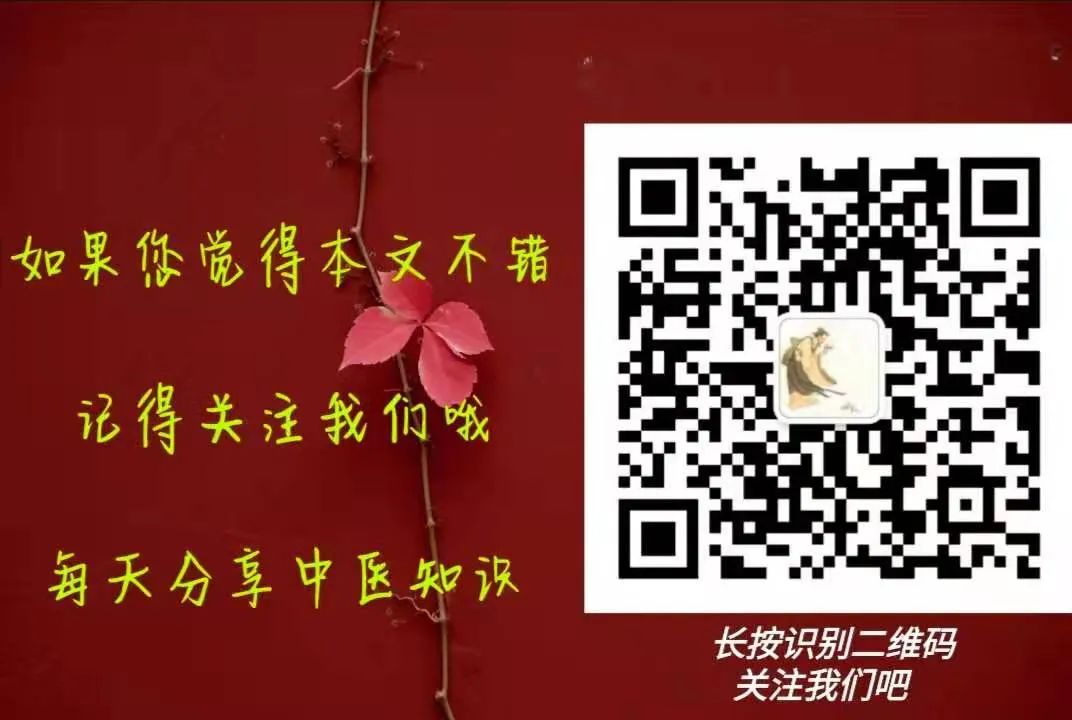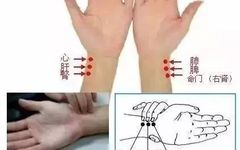The 28 Pulse Qualities
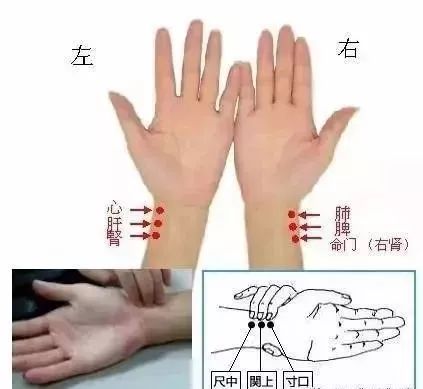
1. Floating Pulse (Fu Mai)
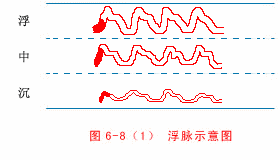
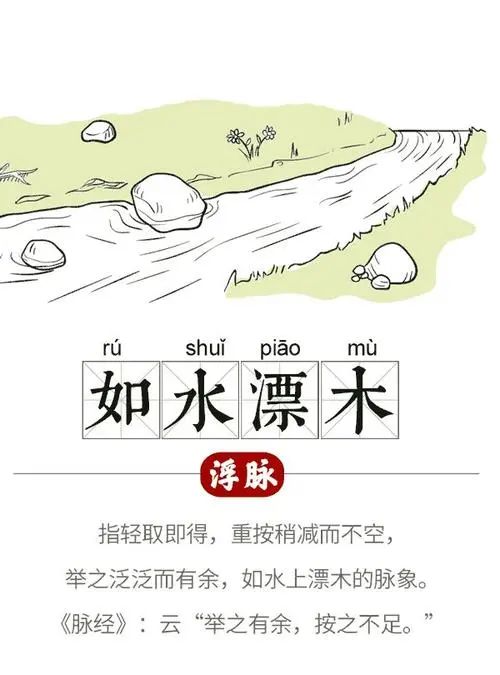
【Body Image Verse】Floating on the surface, like wood floating on water; abundant when lifted, insufficient when pressed.
【Main Disease Verse】Floating pulse is Yang, indicating disease on the surface. Floating at the cun position indicates wind; floating at the left guan indicates wind in the middle jiao; floating at the right guan indicates wind-phlegm in the diaphragm; floating at the chi indicates wind in the lower jiao, with difficulty in urination and constipation.
【Accompanying Pulse Verse】Weak indicates exterior deficiency, strong indicates exterior excess. Floating tight indicates wind-cold, floating slow indicates wind-stroke; floating rapid indicates wind-heat, floating slow indicates wind-damp. Floating empty indicates blood loss, floating short indicates qi deficiency; floating surging indicates empty heat, floating empty indicates summer heat fatigue; floating rough indicates blood injury, floating moist indicates qi failure.
2. Deep Pulse (Chen Mai)
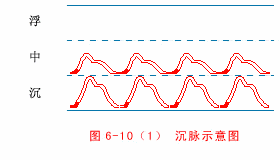
【Body Image Verse】Deep pulse travels through the muscles and bones, like a stone thrown into water; abundant when pressed, insufficient when lifted.
【Main Disease Verse】Deep pulse is Yin, indicating disease within. Deep at the cun position indicates shortness of breath and chest pain; may indicate phlegm or water and blood. Deep at the guan indicates internal cold, causing pain and blockage; may indicate fullness and discomfort, acid reflux, and muscle tension. Deep at the chi indicates back pain, also indicating waist and knee issues; dampness and itching below.
【Accompanying Pulse Verse】Weak indicates internal deficiency, strong indicates internal excess. Deep slow indicates chronic cold, deep rapid indicates internal heat; deep slippery indicates phlegm and water, deep rough indicates blood stasis; deep weak indicates deficiency, deep firm indicates accumulation; deep tight indicates cold pain, deep slow indicates damp cold.
3. Slow Pulse (Chi Mai)
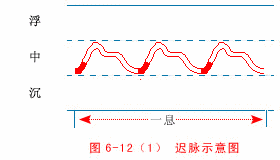
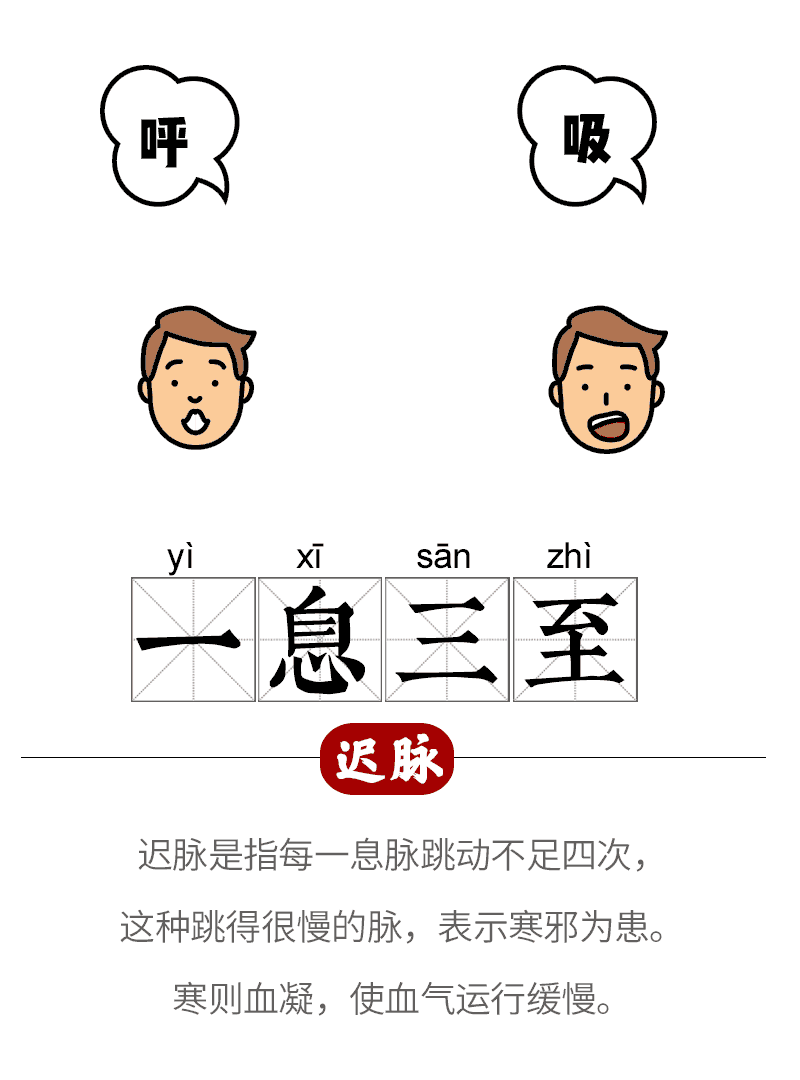
【Body Image Verse】Slow pulse belongs to Yin, characterized by insufficiency; slow and steady, three beats per breath.
【Main Disease Verse】Slow pulse indicates organ issues, primarily due to cold. Slow at the cun indicates upper cold, causing heart pain and stagnation; slow at the guan indicates middle cold, leading to blockages and muscle spasms; slow at the chi indicates fire deficiency, with difficulty in urination and defecation, or issues with the waist and feet, hernia pain.
【Accompanying Pulse Verse】Strong indicates accumulated cold, weak indicates deficiency cold. Floating slow indicates exterior cold, deep slow indicates internal cold; slow rough indicates blood deficiency, slow weak indicates damp cold; slow slippery indicates fullness, slow faint indicates discomfort.
4. Rapid Pulse (Shuo Mai)
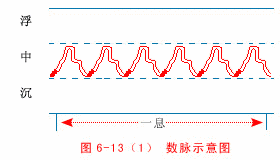

【Body Image Verse】Rapid pulse belongs to Yang, characterized by excess; six beats per breath, coming and going swiftly.
【Main Disease Verse】Rapid pulse indicates issues with the bowels, primarily due to heat. Rapid at the cun indicates wheezing and coughing, mouth sores, and lung issues; rapid at the guan indicates stomach heat, with evil fire attacking; rapid at the chi indicates heart fire, leading to urinary issues.
【Accompanying Pulse Verse】Strong indicates real fire, weak indicates false fire. Floating rapid indicates exterior heat, deep rapid indicates internal heat. Yang rapid indicates fire excess, Yin rapid indicates heart fire. Right rapid indicates excessive fire, left rapid indicates Yin damage.
5. Slippery Pulse (Hua Mai)
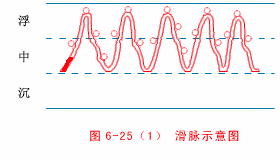
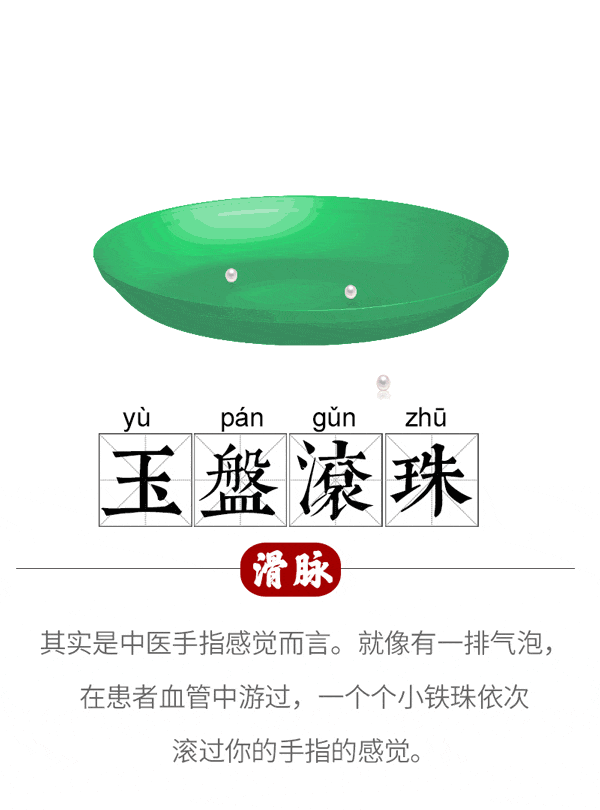
【Body Image Verse】Slippery pulse flows smoothly, like beads rolling; it has the essence of dew.
【Main Disease Verse】Slippery pulse is Yang, often indicating phlegm and saliva. Slippery at the cun indicates coughing, fullness in the chest, and nausea; slippery at the guan indicates stomach heat, obstructing qi and harming food; slippery at the chi indicates urinary issues, or may indicate dysentery, blood in male urination, and menstrual issues in females.
【Accompanying Pulse Verse】Floating slippery indicates wind-phlegm, deep slippery indicates phlegm-food. Slippery rapid indicates phlegm-fire, slippery short indicates qi obstruction. Slippery and floating indicates urinary pain; slippery and floating indicates stroke paralysis. Slippery and harmonious indicates pregnancy can be confirmed.
6. Rough Pulse (Se Mai)
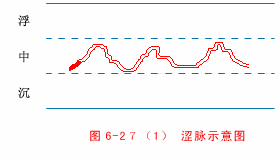
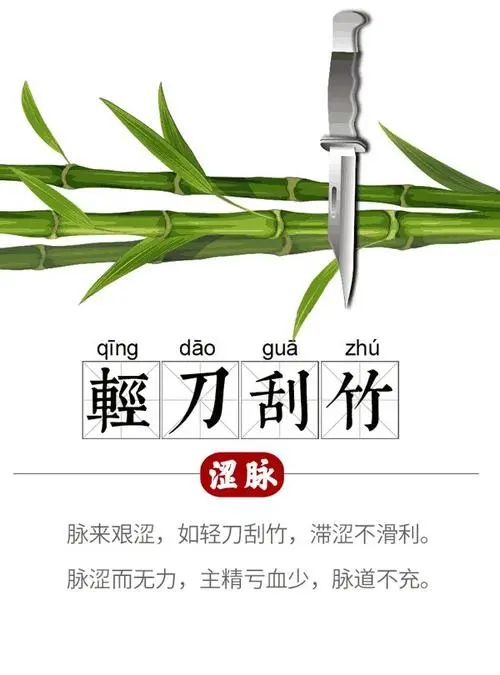
【Body Image Verse】Rough pulse is obstructed, like a knife scraping bamboo; slow, thin, and short, three images fear the feet.
【Main Disease Verse】Rough indicates blood deficiency, also indicating essence injury. Rough at the cun indicates heart pain, or palpitations; rough at the guan indicates Yin deficiency, leading to internal heat; rough at the left guan indicates earth deficiency, left guan indicates fullness. Rough at the chi indicates urinary issues, blood in stool; pregnancy indicates fetal issues, no pregnancy indicates blood depletion.
【Accompanying Pulse Verse】Rough and firm indicates real heat; rough and weak indicates false fire.
7. Weak Pulse (Ruo Mai)

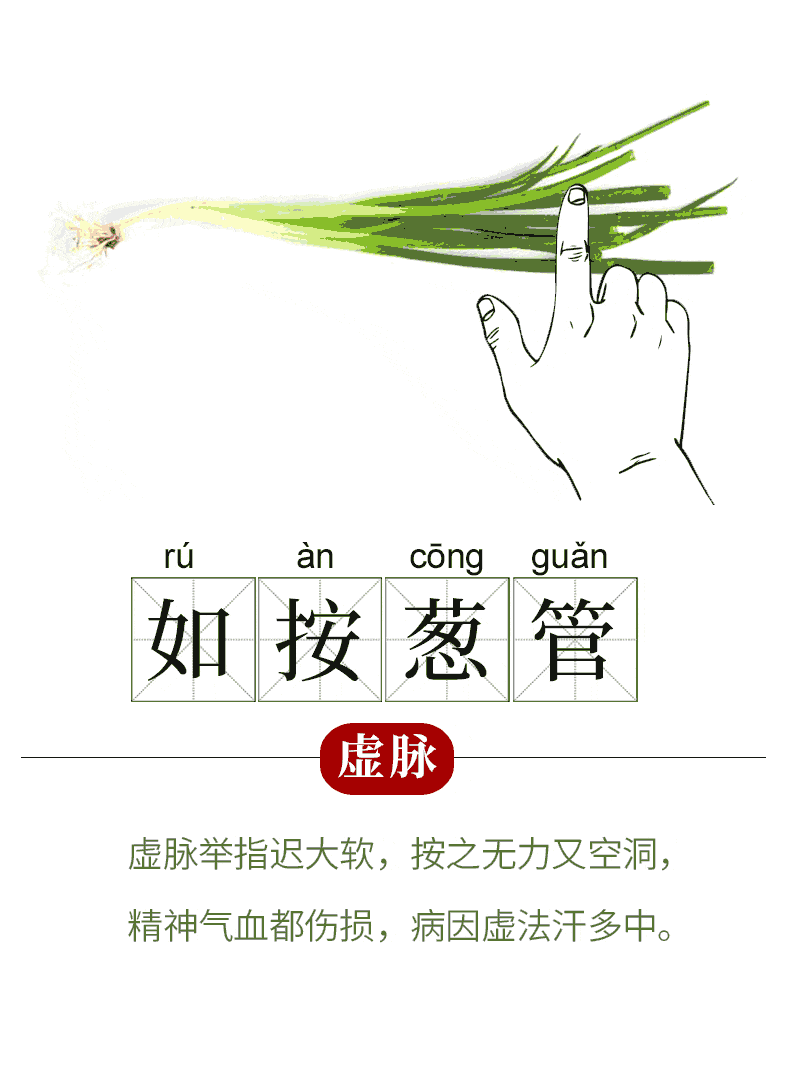
【Body Image Verse】Weak pulse is small and soft, seen in the deep position; absent when lifted, present when pressed.
【Main Disease Verse】Weak indicates Yang deficiency, true qi weakness. Weak at the cun indicates heart deficiency, leading to palpitations and forgetfulness; weak at the right cun indicates lung deficiency, leading to spontaneous sweating and shortness of breath. Weak at the left guan indicates liver damage, blood not nourishing the muscles; weak at the right guan indicates spleen cold, food not digesting. Weak at the left chi indicates water deficiency, waist and knee weakness; weak at the right chi indicates cold symptoms.
8. Full Pulse (Shi Mai)
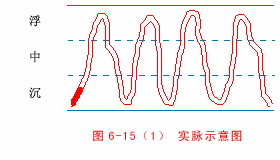
【Body Image Verse】Full pulse is strong, long, and firm; responding to the fingers, all three conditions are present.
【Main Disease Verse】Full blood indicates heat and obstruction. Full at the left cun indicates heart labor, tongue strong and qi surging; full at the right cun indicates lung disease, nausea and throat pain. Full at the left guan indicates liver fire pain; full at the right guan indicates fullness and pain. Full at the left chi indicates constipation and abdominal pain; full at the right chi indicates excessive fire.
【Accompanying Pulse Verse】Full and tight indicates cold accumulation; full and slippery indicates phlegm accumulation.
9. Long Pulse (Chang Mai)
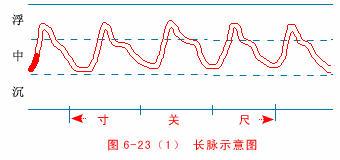
【Body Image Verse】Long pulse is long and straight, both ends are clear; straight up and down, like following a long pole.
【Main Disease Verse】Long indicates excess, qi reversal, and excessive fire. Long at the left cun indicates Yang fire disease; long at the right cun indicates fullness and reversal. Long at the left guan indicates wood excess; long at the right guan indicates earth fullness and bloating. Long at the left chi indicates rebellious qi; long at the right chi indicates excessive fire.
10. Short Pulse (Duan Mai)
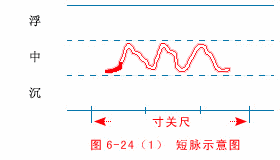
【Body Image Verse】Short pulse is thin and small, both ends are down; protruding in the middle, unable to fill the entire area.
【Main Disease Verse】Short indicates insufficiency, indicating qi deficiency. Short at the cun indicates heart instability; short at the right cun indicates lung deficiency and headache. Short at the left guan indicates liver qi damage; short at the right guan indicates issues in the diaphragm. Short at the left chi indicates lower abdominal pain; short at the right chi indicates true fire not rising.
11. Surging Pulse (Hong Mai)

【Body Image Verse】Surging pulse is extremely large, resembling a flood; coming strong and going light, flowing abundantly.
【Main Disease Verse】Surging indicates fullness, qi obstruction, and excessive fire. Surging at the left cun indicates heart agitation and tongue sores; surging at the right cun indicates chest fullness and qi reversal. Surging at the left guan indicates excessive liver wood; surging at the right guan indicates bloating and heat. Surging at the left chi indicates water depletion; surging at the right chi indicates excessive fire.
12. Faint Pulse (Wei Mai)
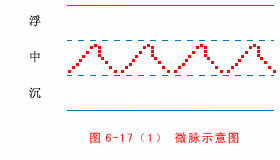
【Body Image Verse】Faint pulse is extremely fine and soft; seemingly present yet almost absent.
【Main Disease Verse】Faint pulse is vague, indicating severe qi and blood deficiency. Faint at the left cun indicates fright; faint at the right cun indicates shortness of breath. Faint at the left guan indicates cold contraction; faint at the right guan indicates stomach cold. Faint at the left chi indicates marrow depletion; faint at the right chi indicates Yang decline and life-threatening.
13. Fine Pulse (Xi Mai)
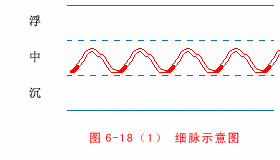
【Body Image Verse】Fine pulse is straight and soft, winding and coiling; resembling silk thread, more apparent than faint.
【Main Disease Verse】Fine indicates qi decline, various deficiencies and damage. Fine at the left cun indicates palpitations and insomnia; fine at the right cun indicates vomiting and shortness of breath. Fine at the left guan indicates liver Yin depletion; fine at the right guan indicates stomach fullness. Fine at the left chi indicates diarrhea and seminal loss; fine at the right chi indicates lower cold fatigue.
14. Moist Pulse (Ru Mai)
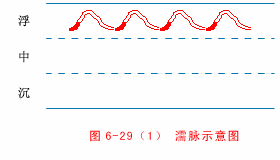
【Body Image Verse】Moist pulse is fine and soft, seen in the floating position; visible when lifted, empty when pressed.
【Main Disease Verse】Moist indicates Yin deficiency, essence depletion. Moist at the left cun indicates forgetfulness and palpitations; moist at the right cun indicates spontaneous sweating. Moist at the left guan indicates blood not nourishing the muscles; moist at the right guan indicates spleen deficiency and dampness. Moist at the left chi indicates blood and essence depletion; moist at the right chi indicates fire failure and life-threatening.
15. Weak Pulse (Ruo Mai)

【Body Image Verse】Weak pulse is small and soft, seen in the deep position; absent when lifted, present when pressed.
【Main Disease Verse】Weak indicates Yang deficiency, true qi weakness. Weak at the left cun indicates heart deficiency, leading to palpitations and forgetfulness; weak at the right cun indicates lung deficiency, leading to spontaneous sweating and shortness of breath. Weak at the left guan indicates liver damage, blood not nourishing the muscles; weak at the right guan indicates spleen cold, food not digesting. Weak at the left chi indicates water deficiency, waist and knee weakness; weak at the right chi indicates cold symptoms.
16. Tight Pulse (Jin Mai)
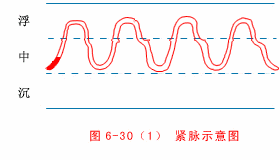
【Body Image Verse】Tight pulse is strong, snapping under the fingers; like a twisted rope, like a tightly pulled string.
【Main Disease Verse】Tight indicates cold evil, also indicating various pains. Tight at the left cun indicates heart fullness and acute pain; tight at the right cun indicates cold damage and wheezing. Tight at the left guan indicates wind-cold; tight at the right guan indicates food obstruction. Tight at the left chi indicates severe pain below the navel; tight at the right chi indicates hernia issues.
17. Slow Pulse (Huan Mai)
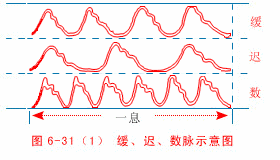
【Body Image Verse】Slow pulse has four beats, coming and going evenly; like a gentle breeze, early spring willows.
【Main Disease and Accompanying Pulse Verse】Slow indicates stomach qi, not indicating disease; only when accompanied can it be diagnosed. Floating slow indicates wind damage, deep slow indicates cold damp. Slow large indicates wind deficiency, slow fine indicates damp obstruction. Slow rough indicates spleen weakness, slow weak indicates qi deficiency. Right cun floating slow indicates wind evil; left cun rough slow indicates Shaoyin blood deficiency.
18. String-like Pulse (Xian Mai)
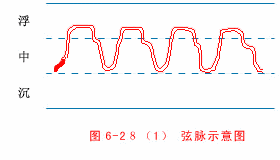
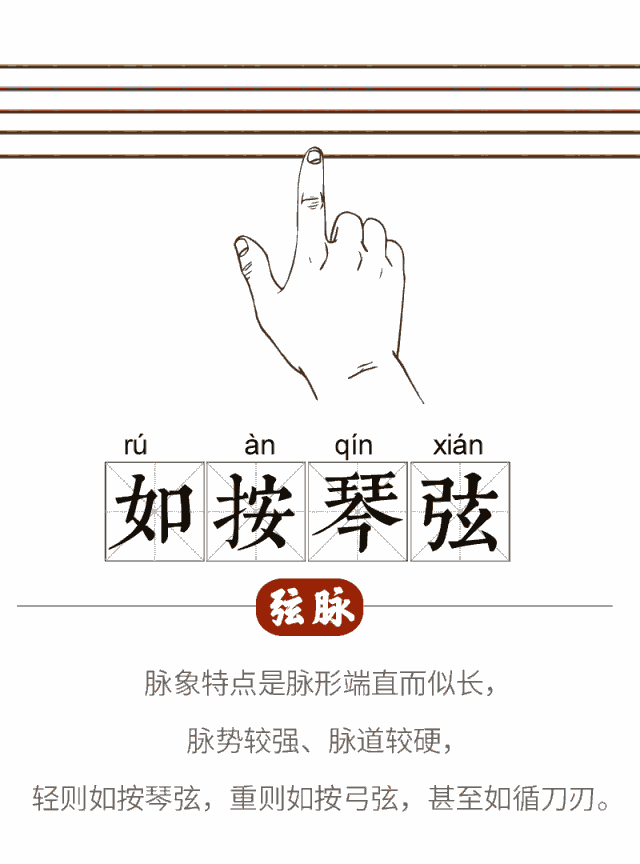
【Body Image Verse】String-like pulse resembles a guitar string, light and soft; straight and long, firm under the fingers.
【Main Disease Verse】String-like indicates liver wind, indicating pain, malaria, phlegm, and fluid retention. String-like at the left cun indicates heart pain; string-like at the right cun indicates chest and head pain. String-like at the left guan indicates phlegm and malaria; string-like at the right guan indicates stomach cold pain. String-like at the left chi indicates fluid retention in the lower jiao; string-like at the right chi indicates leg cramps and pain.
【Accompanying Pulse Verse】Floating string-like indicates fluid retention, deep string-like indicates suspended fluid. String-like rapid indicates heat, string-like slow indicates cold. String-like large indicates deficiency, string-like fine indicates tension. Yang string-like indicates head pain, Yin string-like indicates abdominal pain. Single string-like indicates fluid retention, double string-like indicates cold accumulation.
19. Moving Pulse (Dong Mai)
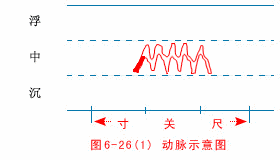
【Body Image Verse】Moving pulse has no head or tail, its movement is like beans; shaking and trembling, must be accompanied by slippery and rapid.
【Main Disease Verse】Moving pulse indicates pain, also indicating fright. Moving at the left cun indicates fright can be diagnosed; moving at the right cun indicates spontaneous sweating without doubt. Moving at the left guan indicates fright and cramping; moving at the right guan indicates heart and spleen pain. Moving at the left chi indicates loss of essence; moving at the right chi indicates excessive fire.
20. Rapid Pulse (Cu Mai)
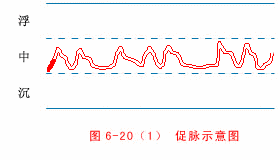
【Body Image Verse】Rapid pulse is quick, stopping intermittently; like rushing and stumbling, advancing leads to death.
【Main Disease Verse】Rapid indicates excessive fire, also due to obstruction. Rapid at the left cun indicates heart fire; rapid at the right cun indicates lung wheezing. Rapid at the left guan indicates blood stagnation; rapid at the right guan indicates food stagnation. Rapid at the left chi indicates slippery issues; rapid at the right chi indicates burning heat.
21. Knotted Pulse (Jie Mai)
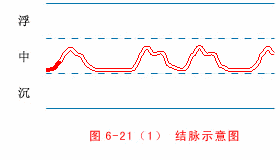
【Body Image Verse】Knotted pulse indicates stagnation, stopping intermittently; moving slowly and lazily, it has its meaning.
【Main Disease Verse】Knotted indicates Yin cold, also due to accumulation. Knotted at the left cun indicates heart cold, pain can be diagnosed; knotted at the right cun indicates lung deficiency, qi cold accumulation; knotted at the left guan indicates hernia; knotted at the right guan indicates phlegm stagnation and food retention. Knotted at the left chi indicates weakness; knotted at the right chi indicates Yin cold symptoms.
22. Intermittent Pulse (Dai Mai)
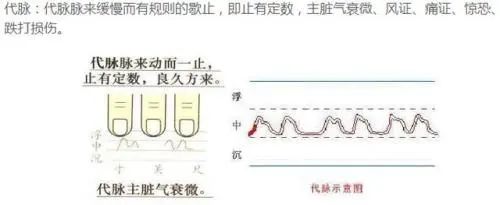
【Body Image Verse】Intermittent pulse indicates a constant number; unable to return, it moves again after a long time.
【Main Disease Verse】Intermittent indicates organ decline, a sign of danger. Spleen deficiency leads to vomiting and diarrhea; internal cold leads to lack of appetite and abdominal pain. Two movements and one stop indicate death in three to four days; four movements and one stop indicate death in six to seven days. Sequentially deducing, do not lose the essence.
23. Leather-like Pulse (Ge Mai)
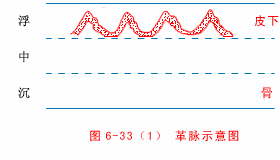
【Body Image Verse】Leather-like pulse is large and tense, easily felt; empty when pressed, like a drum skin.
【Main Disease Verse】Leather-like indicates exterior cold, also indicating internal deficiency. Leather-like at the left cun indicates heart blood deficiency; leather-like at the right cun indicates metal deficiency and qi obstruction. Leather-like at the left guan indicates hernia; leather-like at the right guan indicates earth deficiency and pain. Leather-like at the left chi indicates essence depletion; leather-like at the right chi indicates life-threatening issues. Women may experience postpartum bleeding.
24. Firm Pulse (Lao Mai)
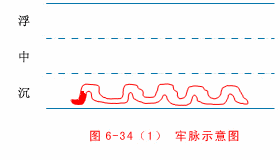
【Body Image Verse】Firm pulse is seen in the deep position, large and string-like; floating in the middle, it cannot be felt.
【Main Disease Verse】Firm indicates accumulation. Disease is internal. Firm at the left cun indicates hidden illness; firm at the right cun indicates stable conditions. Firm at the left guan indicates liver blood accumulation; firm at the right guan indicates cold and fullness. Firm at the left chi indicates hernia issues; firm at the right chi indicates severe pain.
25. Scattered Pulse (San Mai)
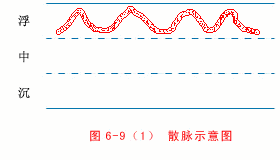
【Body Image Verse】Scattered pulse is floating and chaotic, having surface but no interior; gradually empty in the middle, pressing leads to absence.
【Main Disease Verse】Scattered indicates fundamental injury, indicating danger. Scattered at the left cun indicates palpitations and insomnia; scattered at the right cun indicates spontaneous sweating. Scattered at the left guan indicates fluid retention; scattered at the right guan indicates fullness and illness. Located at the left chi indicates water depletion; scattered at the right chi indicates Yang depletion and life-threatening.
26. Hollow Pulse (Kao Mai)
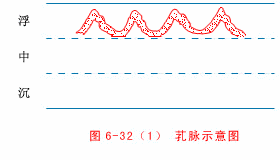
【Body Image Verse】Hollow pulse is like a plant, resembling scallions; both floating and deep, empty in the middle.
【Main Disease Verse】Hollow pulse indicates emptiness, hence indicating blood loss. Hollow at the left cun indicates heart blood loss; hollow at the right cun indicates Yin injury. Hollow at the left guan indicates liver blood not stored; hollow at the right guan indicates spleen blood not absorbed. Hollow at the left chi indicates red stool; hollow at the right chi indicates fire and essence leakage.
27. Hidden Pulse (Fu Mai)

【Body Image Verse】Hidden pulse is concealed, deeper than deep; pressing the muscles reveals its shape.
【Main Disease Verse】Hidden pulse is Yin, indicating deep-seated illness. Hidden at the left cun indicates blood stagnation; hidden at the right cun indicates qi stagnation. Hidden at the left guan indicates liver blood in the abdomen; hidden at the right guan indicates cold and dampness. Hidden at the left chi indicates hernia issues; hidden at the right chi indicates fire depletion.
28. Rapid Pulse (Ji Mai)
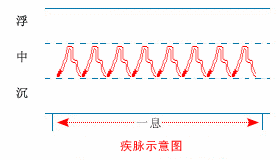
【Body Image Verse】Rapid indicates urgency, extremely rapid; seven to eight beats, pulse flows thin and rapid.
【Main Disease Verse】Rapid indicates extreme Yang, Yin qi is about to deplete; pulse deviates from the norm, spirit is about to perish; gradually advancing and becoming rapid, often leading to death. Rapid at the left cun indicates do not suppress self; rapid at the right cun indicates metal is being consumed by fire. Rapid at the left guan indicates liver Yin has been depleted; rapid at the right guan indicates spleen Yin has been exhausted. Rapid at the left chi indicates difficulty in moistening; rapid at the right chi indicates excessive heat.
Note: The various prescriptions and formulas mentioned in this article are for reference and study by professional TCM practitioners only and should not be used as prescriptions. Please do not self-medicate; seek medical attention if you experience discomfort.
Copyright Notice: This article is reproduced from the internet. If there is any infringement, please contact for removal!
For submissions or reprints, please contact QQ/WeChat: 1612237026
THE END
